Operations and Project Management: Unit 16 Report for Business Growth
VerifiedAdded on 2021/02/19
|20
|4789
|108
Report
AI Summary
This report delves into the core principles of operations and project management, with a specific focus on their application within Samsung, a multinational conglomerate. The report explores the effectiveness of operations management, highlighting lean and Six Sigma principles for continuous improvement. It examines the concept of continuous improvement through the Plan-Do-Check-Act cycle and the Kaizen model, analyzing their impact on operational efficiency. Furthermore, the report investigates the application of the Project Life Cycle (PLC), defining its stages and analyzing project methodologies. The study evaluates the PLC through theoretical and practical exploration, providing a comprehensive overview of its significance in successful project management. The report emphasizes key concepts such as accountability, customer value, and process improvement to improve business growth.
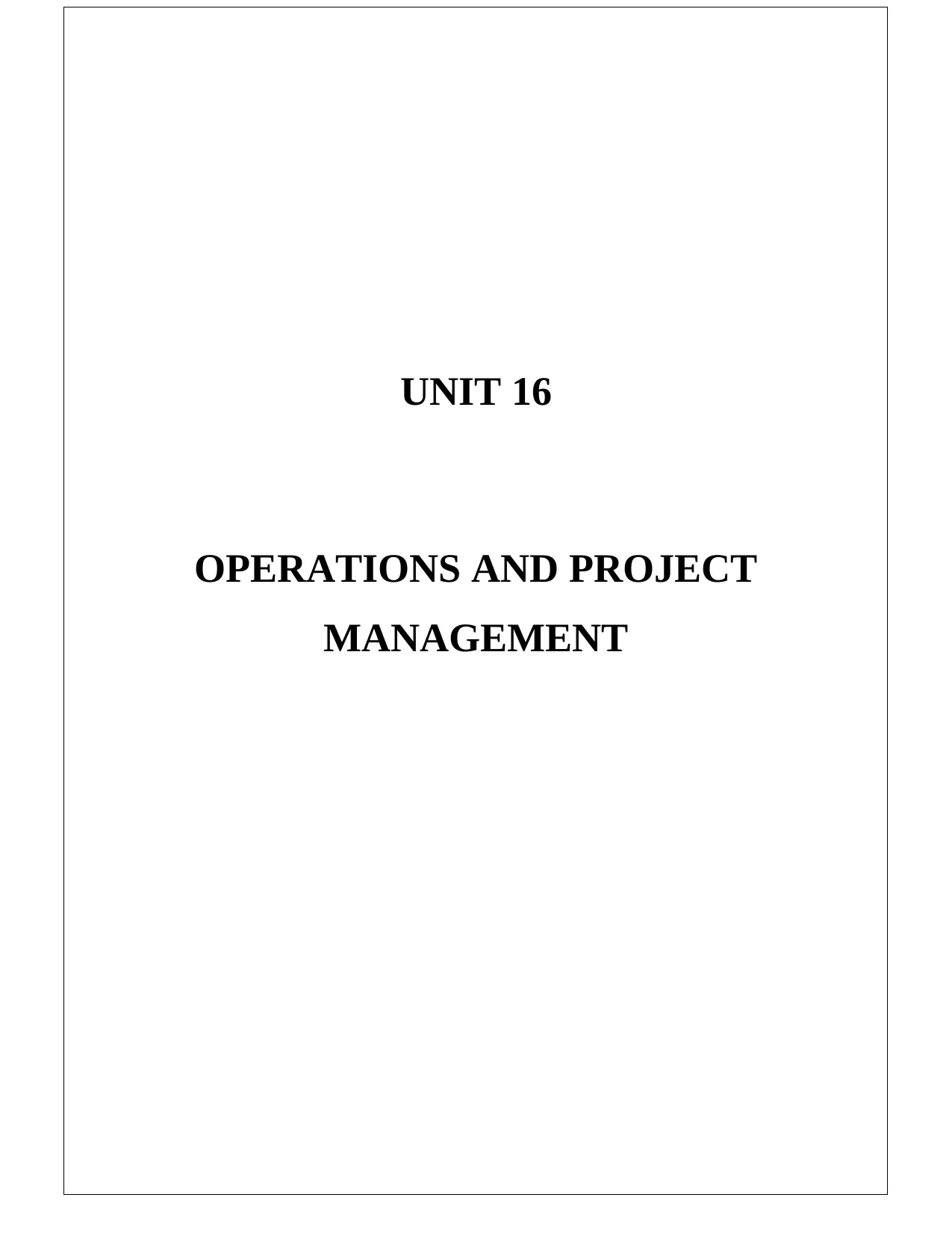
UNIT 16
OPERATIONS AND PROJECT
MANAGEMENT
OPERATIONS AND PROJECT
MANAGEMENT
Paraphrase This Document
Need a fresh take? Get an instant paraphrase of this document with our AI Paraphraser
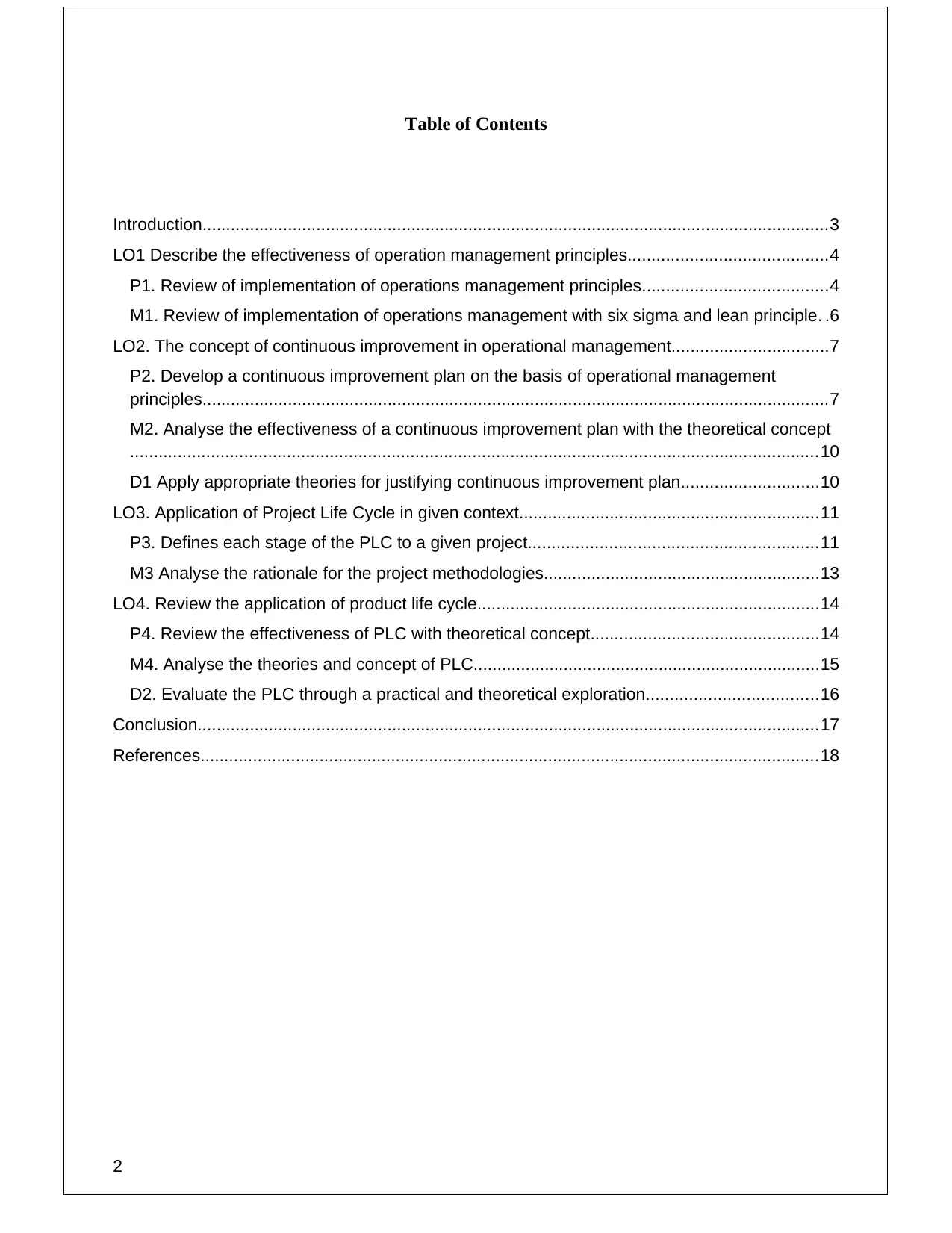
Table of Contents
Introduction....................................................................................................................................3
LO1 Describe the effectiveness of operation management principles..........................................4
P1. Review of implementation of operations management principles.......................................4
M1. Review of implementation of operations management with six sigma and lean principle. .6
LO2. The concept of continuous improvement in operational management.................................7
P2. Develop a continuous improvement plan on the basis of operational management
principles....................................................................................................................................7
M2. Analyse the effectiveness of a continuous improvement plan with the theoretical concept
.................................................................................................................................................10
D1 Apply appropriate theories for justifying continuous improvement plan.............................10
LO3. Application of Project Life Cycle in given context...............................................................11
P3. Defines each stage of the PLC to a given project.............................................................11
M3 Analyse the rationale for the project methodologies..........................................................13
LO4. Review the application of product life cycle........................................................................14
P4. Review the effectiveness of PLC with theoretical concept................................................14
M4. Analyse the theories and concept of PLC.........................................................................15
D2. Evaluate the PLC through a practical and theoretical exploration....................................16
Conclusion...................................................................................................................................17
References..................................................................................................................................18
2
Introduction....................................................................................................................................3
LO1 Describe the effectiveness of operation management principles..........................................4
P1. Review of implementation of operations management principles.......................................4
M1. Review of implementation of operations management with six sigma and lean principle. .6
LO2. The concept of continuous improvement in operational management.................................7
P2. Develop a continuous improvement plan on the basis of operational management
principles....................................................................................................................................7
M2. Analyse the effectiveness of a continuous improvement plan with the theoretical concept
.................................................................................................................................................10
D1 Apply appropriate theories for justifying continuous improvement plan.............................10
LO3. Application of Project Life Cycle in given context...............................................................11
P3. Defines each stage of the PLC to a given project.............................................................11
M3 Analyse the rationale for the project methodologies..........................................................13
LO4. Review the application of product life cycle........................................................................14
P4. Review the effectiveness of PLC with theoretical concept................................................14
M4. Analyse the theories and concept of PLC.........................................................................15
D2. Evaluate the PLC through a practical and theoretical exploration....................................16
Conclusion...................................................................................................................................17
References..................................................................................................................................18
2
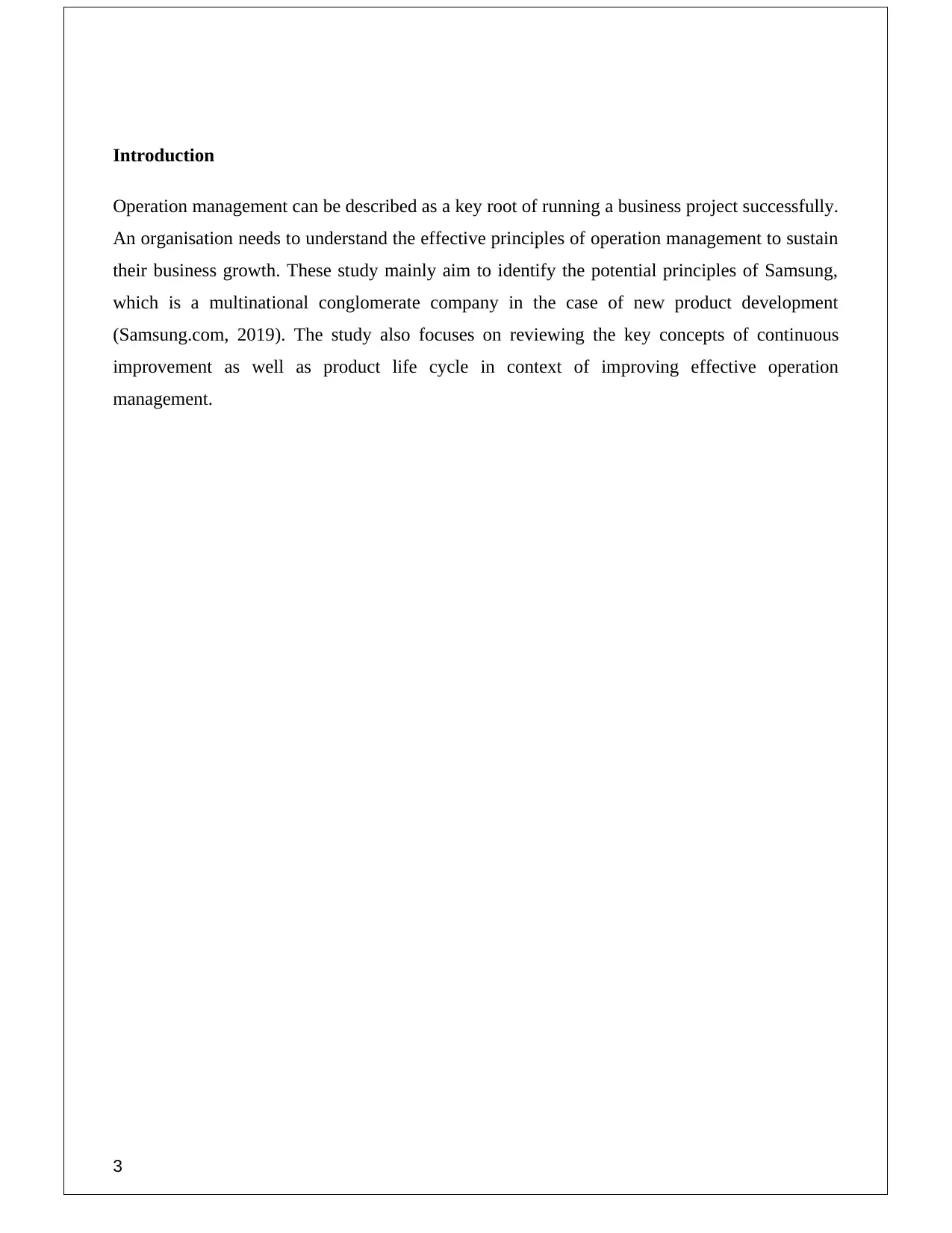
Introduction
Operation management can be described as a key root of running a business project successfully.
An organisation needs to understand the effective principles of operation management to sustain
their business growth. These study mainly aim to identify the potential principles of Samsung,
which is a multinational conglomerate company in the case of new product development
(Samsung.com, 2019). The study also focuses on reviewing the key concepts of continuous
improvement as well as product life cycle in context of improving effective operation
management.
3
Operation management can be described as a key root of running a business project successfully.
An organisation needs to understand the effective principles of operation management to sustain
their business growth. These study mainly aim to identify the potential principles of Samsung,
which is a multinational conglomerate company in the case of new product development
(Samsung.com, 2019). The study also focuses on reviewing the key concepts of continuous
improvement as well as product life cycle in context of improving effective operation
management.
3
⊘ This is a preview!⊘
Do you want full access?
Subscribe today to unlock all pages.

Trusted by 1+ million students worldwide
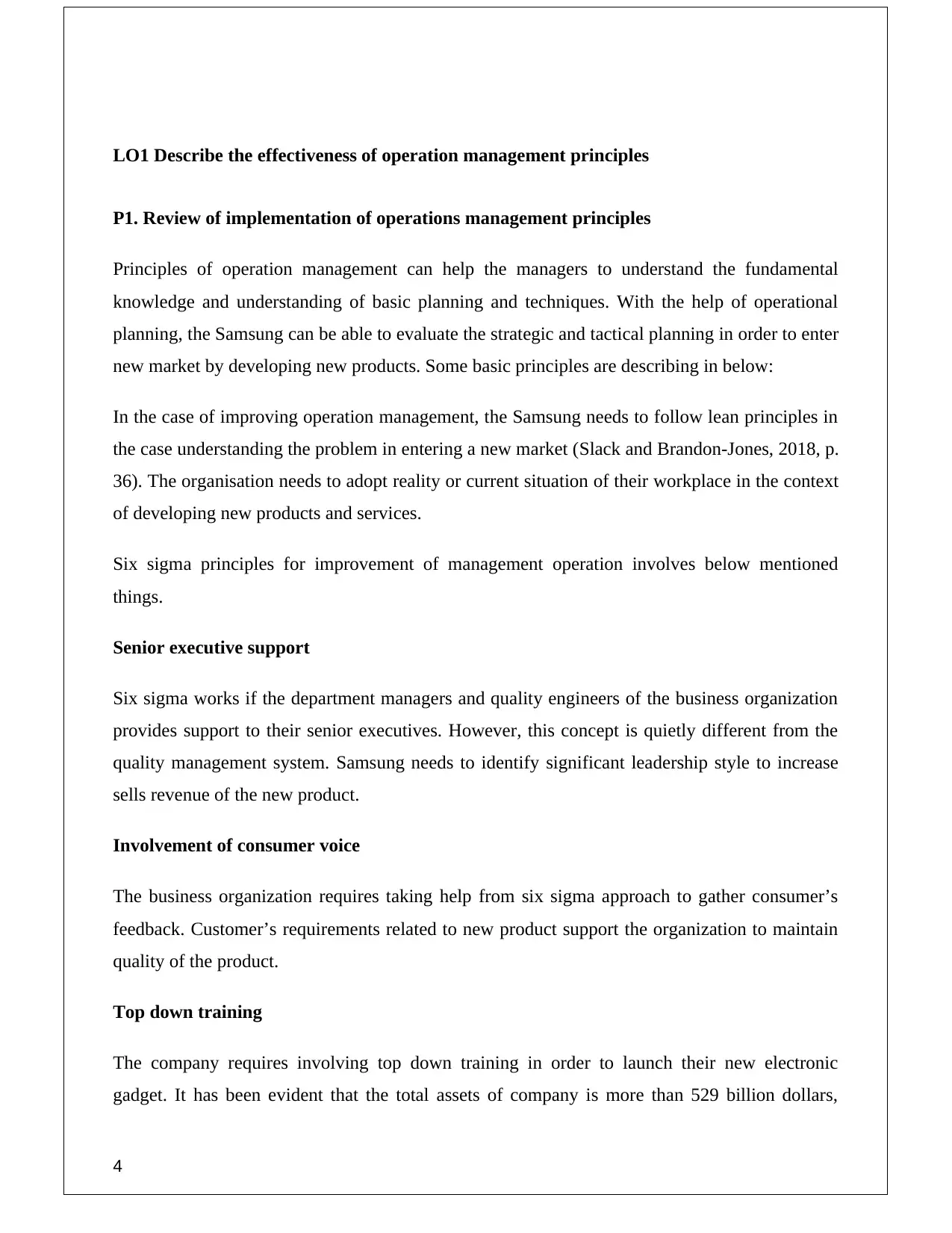
LO1 Describe the effectiveness of operation management principles
P1. Review of implementation of operations management principles
Principles of operation management can help the managers to understand the fundamental
knowledge and understanding of basic planning and techniques. With the help of operational
planning, the Samsung can be able to evaluate the strategic and tactical planning in order to enter
new market by developing new products. Some basic principles are describing in below:
In the case of improving operation management, the Samsung needs to follow lean principles in
the case understanding the problem in entering a new market (Slack and Brandon-Jones, 2018, p.
36). The organisation needs to adopt reality or current situation of their workplace in the context
of developing new products and services.
Six sigma principles for improvement of management operation involves below mentioned
things.
Senior executive support
Six sigma works if the department managers and quality engineers of the business organization
provides support to their senior executives. However, this concept is quietly different from the
quality management system. Samsung needs to identify significant leadership style to increase
sells revenue of the new product.
Involvement of consumer voice
The business organization requires taking help from six sigma approach to gather consumer’s
feedback. Customer’s requirements related to new product support the organization to maintain
quality of the product.
Top down training
The company requires involving top down training in order to launch their new electronic
gadget. It has been evident that the total assets of company is more than 529 billion dollars,
4
P1. Review of implementation of operations management principles
Principles of operation management can help the managers to understand the fundamental
knowledge and understanding of basic planning and techniques. With the help of operational
planning, the Samsung can be able to evaluate the strategic and tactical planning in order to enter
new market by developing new products. Some basic principles are describing in below:
In the case of improving operation management, the Samsung needs to follow lean principles in
the case understanding the problem in entering a new market (Slack and Brandon-Jones, 2018, p.
36). The organisation needs to adopt reality or current situation of their workplace in the context
of developing new products and services.
Six sigma principles for improvement of management operation involves below mentioned
things.
Senior executive support
Six sigma works if the department managers and quality engineers of the business organization
provides support to their senior executives. However, this concept is quietly different from the
quality management system. Samsung needs to identify significant leadership style to increase
sells revenue of the new product.
Involvement of consumer voice
The business organization requires taking help from six sigma approach to gather consumer’s
feedback. Customer’s requirements related to new product support the organization to maintain
quality of the product.
Top down training
The company requires involving top down training in order to launch their new electronic
gadget. It has been evident that the total assets of company is more than 529 billion dollars,
4
Paraphrase This Document
Need a fresh take? Get an instant paraphrase of this document with our AI Paraphraser
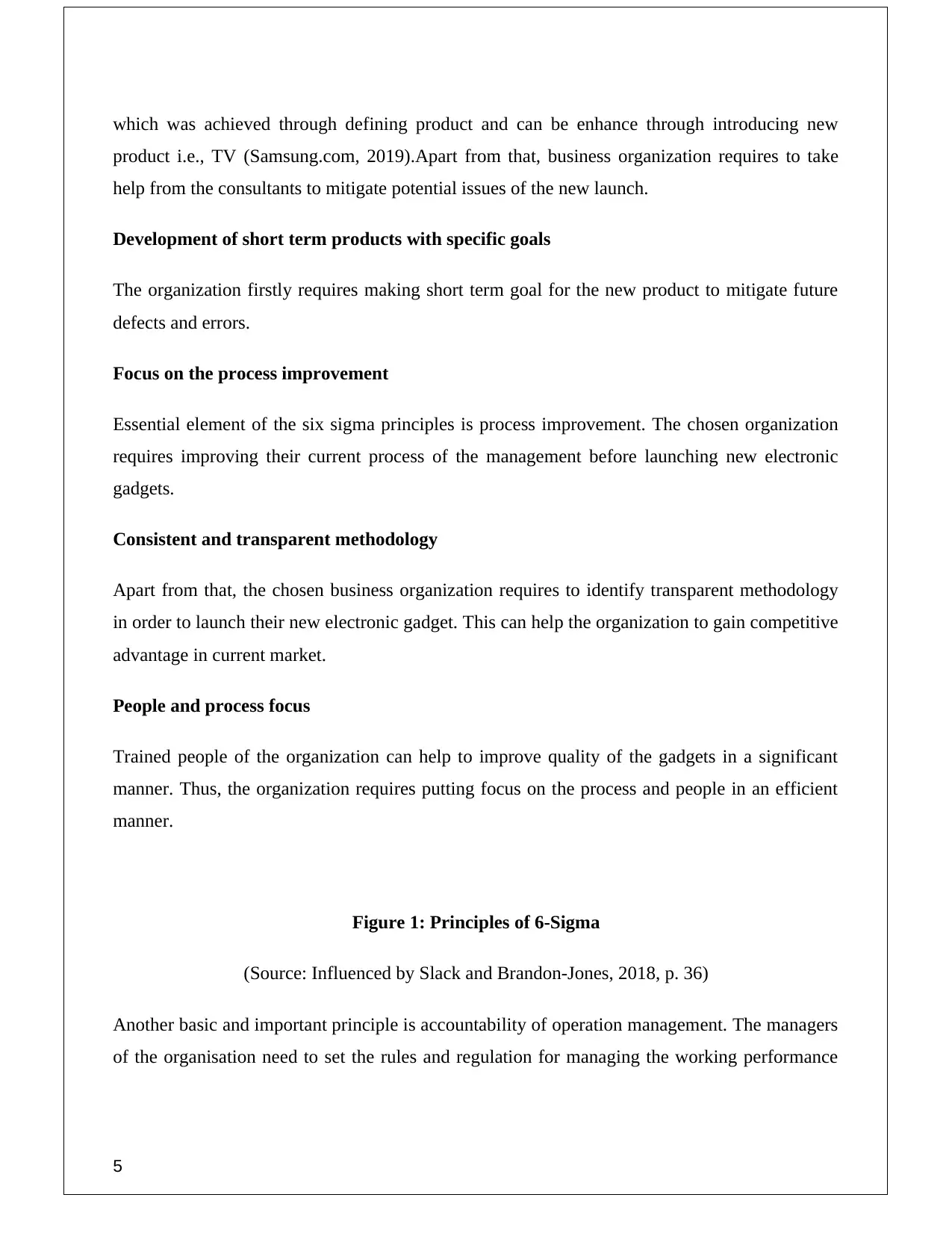
which was achieved through defining product and can be enhance through introducing new
product i.e., TV (Samsung.com, 2019).Apart from that, business organization requires to take
help from the consultants to mitigate potential issues of the new launch.
Development of short term products with specific goals
The organization firstly requires making short term goal for the new product to mitigate future
defects and errors.
Focus on the process improvement
Essential element of the six sigma principles is process improvement. The chosen organization
requires improving their current process of the management before launching new electronic
gadgets.
Consistent and transparent methodology
Apart from that, the chosen business organization requires to identify transparent methodology
in order to launch their new electronic gadget. This can help the organization to gain competitive
advantage in current market.
People and process focus
Trained people of the organization can help to improve quality of the gadgets in a significant
manner. Thus, the organization requires putting focus on the process and people in an efficient
manner.
Figure 1: Principles of 6-Sigma
(Source: Influenced by Slack and Brandon-Jones, 2018, p. 36)
Another basic and important principle is accountability of operation management. The managers
of the organisation need to set the rules and regulation for managing the working performance
5
product i.e., TV (Samsung.com, 2019).Apart from that, business organization requires to take
help from the consultants to mitigate potential issues of the new launch.
Development of short term products with specific goals
The organization firstly requires making short term goal for the new product to mitigate future
defects and errors.
Focus on the process improvement
Essential element of the six sigma principles is process improvement. The chosen organization
requires improving their current process of the management before launching new electronic
gadgets.
Consistent and transparent methodology
Apart from that, the chosen business organization requires to identify transparent methodology
in order to launch their new electronic gadget. This can help the organization to gain competitive
advantage in current market.
People and process focus
Trained people of the organization can help to improve quality of the gadgets in a significant
manner. Thus, the organization requires putting focus on the process and people in an efficient
manner.
Figure 1: Principles of 6-Sigma
(Source: Influenced by Slack and Brandon-Jones, 2018, p. 36)
Another basic and important principle is accountability of operation management. The managers
of the organisation need to set the rules and regulation for managing the working performance
5
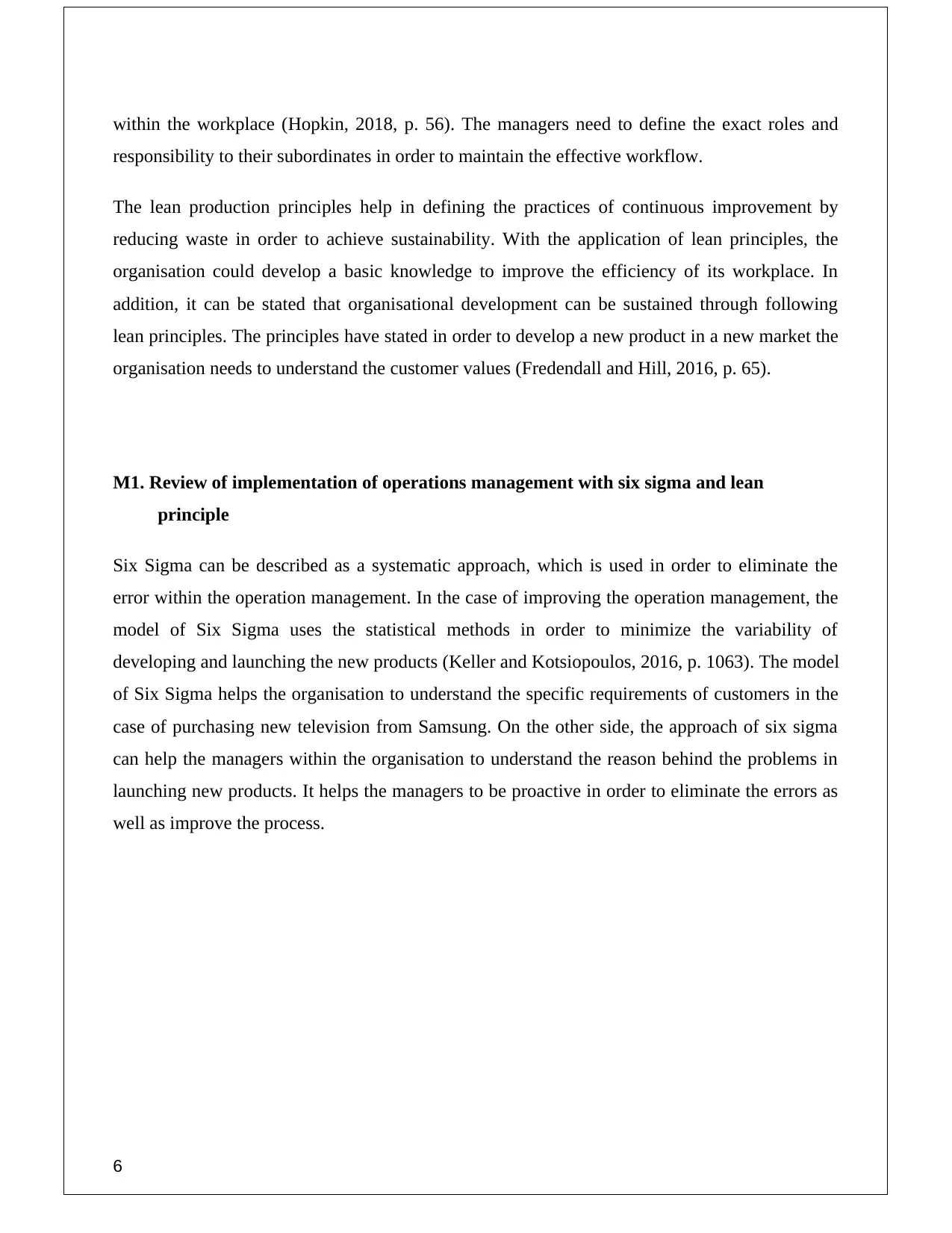
within the workplace (Hopkin, 2018, p. 56). The managers need to define the exact roles and
responsibility to their subordinates in order to maintain the effective workflow.
The lean production principles help in defining the practices of continuous improvement by
reducing waste in order to achieve sustainability. With the application of lean principles, the
organisation could develop a basic knowledge to improve the efficiency of its workplace. In
addition, it can be stated that organisational development can be sustained through following
lean principles. The principles have stated in order to develop a new product in a new market the
organisation needs to understand the customer values (Fredendall and Hill, 2016, p. 65).
M1. Review of implementation of operations management with six sigma and lean
principle
Six Sigma can be described as a systematic approach, which is used in order to eliminate the
error within the operation management. In the case of improving the operation management, the
model of Six Sigma uses the statistical methods in order to minimize the variability of
developing and launching the new products (Keller and Kotsiopoulos, 2016, p. 1063). The model
of Six Sigma helps the organisation to understand the specific requirements of customers in the
case of purchasing new television from Samsung. On the other side, the approach of six sigma
can help the managers within the organisation to understand the reason behind the problems in
launching new products. It helps the managers to be proactive in order to eliminate the errors as
well as improve the process.
6
responsibility to their subordinates in order to maintain the effective workflow.
The lean production principles help in defining the practices of continuous improvement by
reducing waste in order to achieve sustainability. With the application of lean principles, the
organisation could develop a basic knowledge to improve the efficiency of its workplace. In
addition, it can be stated that organisational development can be sustained through following
lean principles. The principles have stated in order to develop a new product in a new market the
organisation needs to understand the customer values (Fredendall and Hill, 2016, p. 65).
M1. Review of implementation of operations management with six sigma and lean
principle
Six Sigma can be described as a systematic approach, which is used in order to eliminate the
error within the operation management. In the case of improving the operation management, the
model of Six Sigma uses the statistical methods in order to minimize the variability of
developing and launching the new products (Keller and Kotsiopoulos, 2016, p. 1063). The model
of Six Sigma helps the organisation to understand the specific requirements of customers in the
case of purchasing new television from Samsung. On the other side, the approach of six sigma
can help the managers within the organisation to understand the reason behind the problems in
launching new products. It helps the managers to be proactive in order to eliminate the errors as
well as improve the process.
6
⊘ This is a preview!⊘
Do you want full access?
Subscribe today to unlock all pages.

Trusted by 1+ million students worldwide
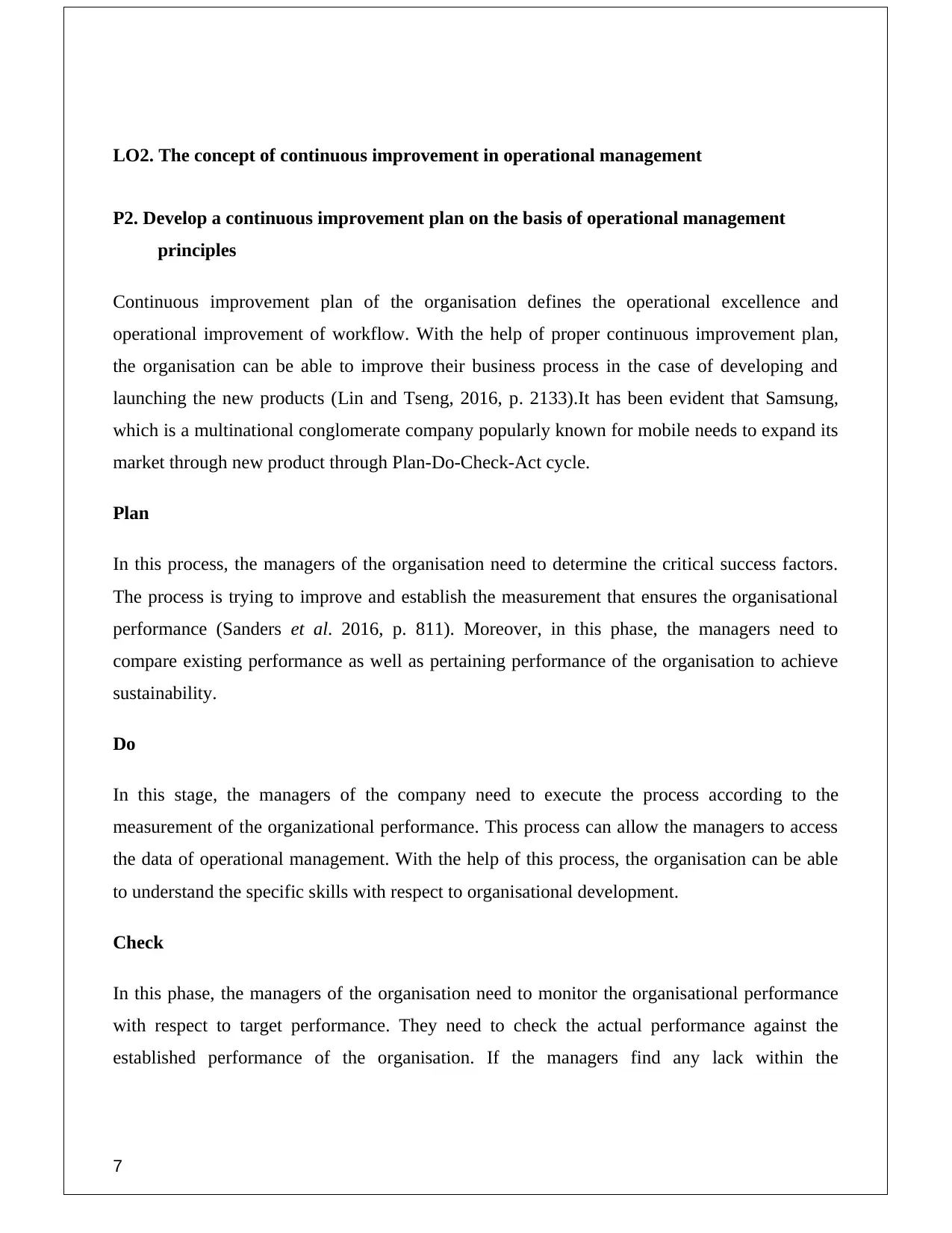
LO2. The concept of continuous improvement in operational management
P2. Develop a continuous improvement plan on the basis of operational management
principles
Continuous improvement plan of the organisation defines the operational excellence and
operational improvement of workflow. With the help of proper continuous improvement plan,
the organisation can be able to improve their business process in the case of developing and
launching the new products (Lin and Tseng, 2016, p. 2133).It has been evident that Samsung,
which is a multinational conglomerate company popularly known for mobile needs to expand its
market through new product through Plan-Do-Check-Act cycle.
Plan
In this process, the managers of the organisation need to determine the critical success factors.
The process is trying to improve and establish the measurement that ensures the organisational
performance (Sanders et al. 2016, p. 811). Moreover, in this phase, the managers need to
compare existing performance as well as pertaining performance of the organisation to achieve
sustainability.
Do
In this stage, the managers of the company need to execute the process according to the
measurement of the organizational performance. This process can allow the managers to access
the data of operational management. With the help of this process, the organisation can be able
to understand the specific skills with respect to organisational development.
Check
In this phase, the managers of the organisation need to monitor the organisational performance
with respect to target performance. They need to check the actual performance against the
established performance of the organisation. If the managers find any lack within the
7
P2. Develop a continuous improvement plan on the basis of operational management
principles
Continuous improvement plan of the organisation defines the operational excellence and
operational improvement of workflow. With the help of proper continuous improvement plan,
the organisation can be able to improve their business process in the case of developing and
launching the new products (Lin and Tseng, 2016, p. 2133).It has been evident that Samsung,
which is a multinational conglomerate company popularly known for mobile needs to expand its
market through new product through Plan-Do-Check-Act cycle.
Plan
In this process, the managers of the organisation need to determine the critical success factors.
The process is trying to improve and establish the measurement that ensures the organisational
performance (Sanders et al. 2016, p. 811). Moreover, in this phase, the managers need to
compare existing performance as well as pertaining performance of the organisation to achieve
sustainability.
Do
In this stage, the managers of the company need to execute the process according to the
measurement of the organizational performance. This process can allow the managers to access
the data of operational management. With the help of this process, the organisation can be able
to understand the specific skills with respect to organisational development.
Check
In this phase, the managers of the organisation need to monitor the organisational performance
with respect to target performance. They need to check the actual performance against the
established performance of the organisation. If the managers find any lack within the
7
Paraphrase This Document
Need a fresh take? Get an instant paraphrase of this document with our AI Paraphraser
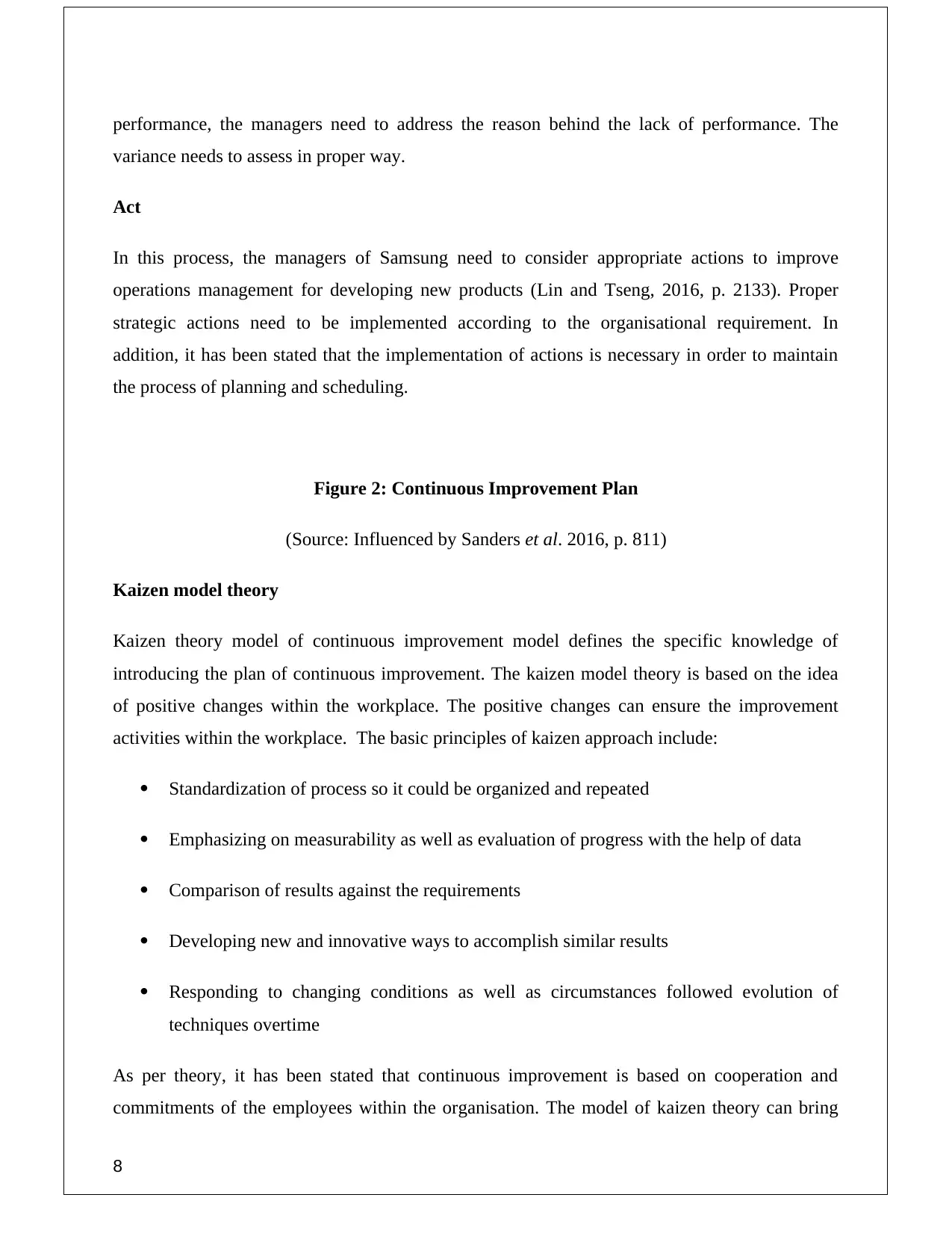
performance, the managers need to address the reason behind the lack of performance. The
variance needs to assess in proper way.
Act
In this process, the managers of Samsung need to consider appropriate actions to improve
operations management for developing new products (Lin and Tseng, 2016, p. 2133). Proper
strategic actions need to be implemented according to the organisational requirement. In
addition, it has been stated that the implementation of actions is necessary in order to maintain
the process of planning and scheduling.
Figure 2: Continuous Improvement Plan
(Source: Influenced by Sanders et al. 2016, p. 811)
Kaizen model theory
Kaizen theory model of continuous improvement model defines the specific knowledge of
introducing the plan of continuous improvement. The kaizen model theory is based on the idea
of positive changes within the workplace. The positive changes can ensure the improvement
activities within the workplace. The basic principles of kaizen approach include:
Standardization of process so it could be organized and repeated
Emphasizing on measurability as well as evaluation of progress with the help of data
Comparison of results against the requirements
Developing new and innovative ways to accomplish similar results
Responding to changing conditions as well as circumstances followed evolution of
techniques overtime
As per theory, it has been stated that continuous improvement is based on cooperation and
commitments of the employees within the organisation. The model of kaizen theory can bring
8
variance needs to assess in proper way.
Act
In this process, the managers of Samsung need to consider appropriate actions to improve
operations management for developing new products (Lin and Tseng, 2016, p. 2133). Proper
strategic actions need to be implemented according to the organisational requirement. In
addition, it has been stated that the implementation of actions is necessary in order to maintain
the process of planning and scheduling.
Figure 2: Continuous Improvement Plan
(Source: Influenced by Sanders et al. 2016, p. 811)
Kaizen model theory
Kaizen theory model of continuous improvement model defines the specific knowledge of
introducing the plan of continuous improvement. The kaizen model theory is based on the idea
of positive changes within the workplace. The positive changes can ensure the improvement
activities within the workplace. The basic principles of kaizen approach include:
Standardization of process so it could be organized and repeated
Emphasizing on measurability as well as evaluation of progress with the help of data
Comparison of results against the requirements
Developing new and innovative ways to accomplish similar results
Responding to changing conditions as well as circumstances followed evolution of
techniques overtime
As per theory, it has been stated that continuous improvement is based on cooperation and
commitments of the employees within the organisation. The model of kaizen theory can bring
8

radical changes within the organisation that ensure the significant transformation of the
organisation.
9
organisation.
9
⊘ This is a preview!⊘
Do you want full access?
Subscribe today to unlock all pages.

Trusted by 1+ million students worldwide
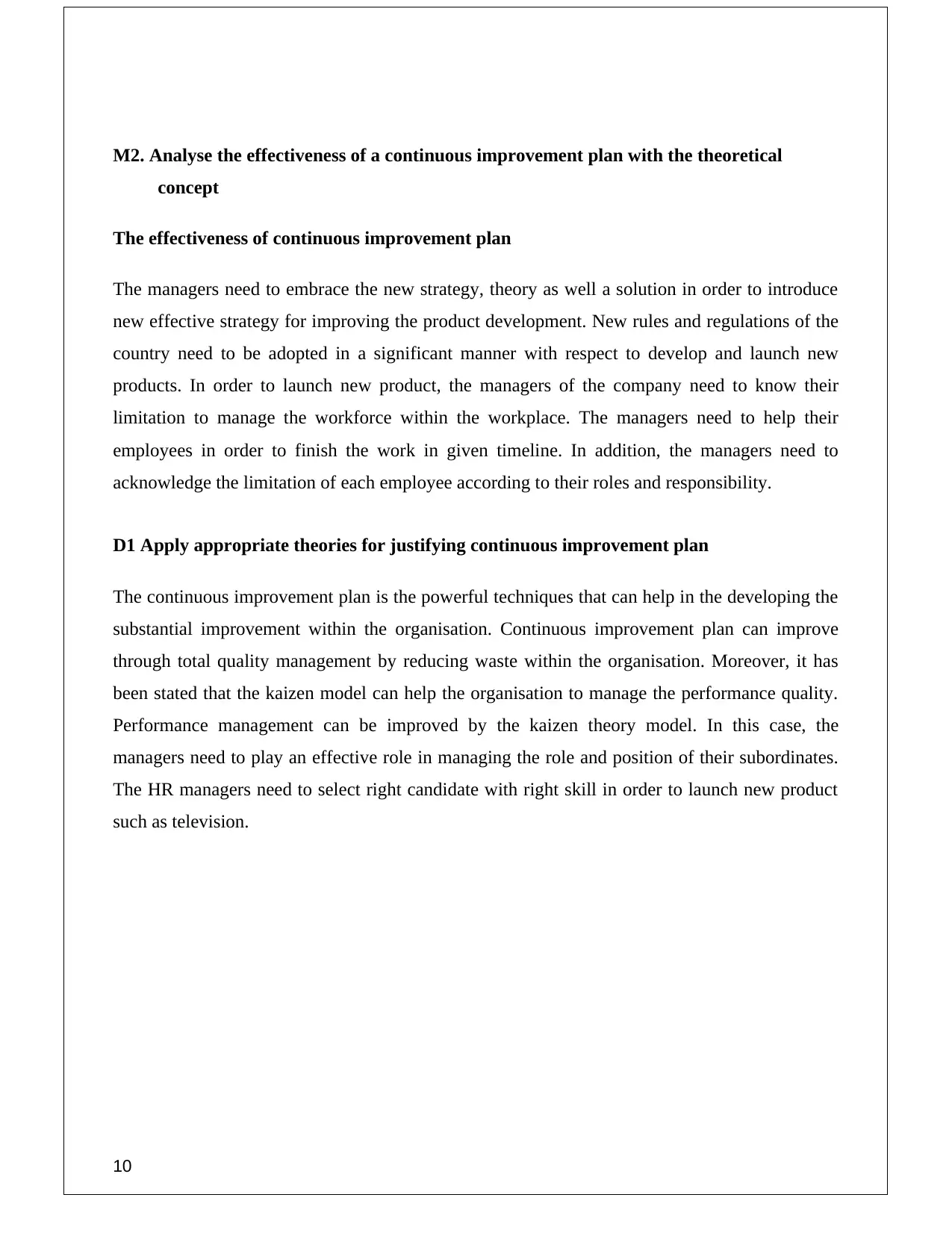
M2. Analyse the effectiveness of a continuous improvement plan with the theoretical
concept
The effectiveness of continuous improvement plan
The managers need to embrace the new strategy, theory as well a solution in order to introduce
new effective strategy for improving the product development. New rules and regulations of the
country need to be adopted in a significant manner with respect to develop and launch new
products. In order to launch new product, the managers of the company need to know their
limitation to manage the workforce within the workplace. The managers need to help their
employees in order to finish the work in given timeline. In addition, the managers need to
acknowledge the limitation of each employee according to their roles and responsibility.
D1 Apply appropriate theories for justifying continuous improvement plan
The continuous improvement plan is the powerful techniques that can help in the developing the
substantial improvement within the organisation. Continuous improvement plan can improve
through total quality management by reducing waste within the organisation. Moreover, it has
been stated that the kaizen model can help the organisation to manage the performance quality.
Performance management can be improved by the kaizen theory model. In this case, the
managers need to play an effective role in managing the role and position of their subordinates.
The HR managers need to select right candidate with right skill in order to launch new product
such as television.
10
concept
The effectiveness of continuous improvement plan
The managers need to embrace the new strategy, theory as well a solution in order to introduce
new effective strategy for improving the product development. New rules and regulations of the
country need to be adopted in a significant manner with respect to develop and launch new
products. In order to launch new product, the managers of the company need to know their
limitation to manage the workforce within the workplace. The managers need to help their
employees in order to finish the work in given timeline. In addition, the managers need to
acknowledge the limitation of each employee according to their roles and responsibility.
D1 Apply appropriate theories for justifying continuous improvement plan
The continuous improvement plan is the powerful techniques that can help in the developing the
substantial improvement within the organisation. Continuous improvement plan can improve
through total quality management by reducing waste within the organisation. Moreover, it has
been stated that the kaizen model can help the organisation to manage the performance quality.
Performance management can be improved by the kaizen theory model. In this case, the
managers need to play an effective role in managing the role and position of their subordinates.
The HR managers need to select right candidate with right skill in order to launch new product
such as television.
10
Paraphrase This Document
Need a fresh take? Get an instant paraphrase of this document with our AI Paraphraser
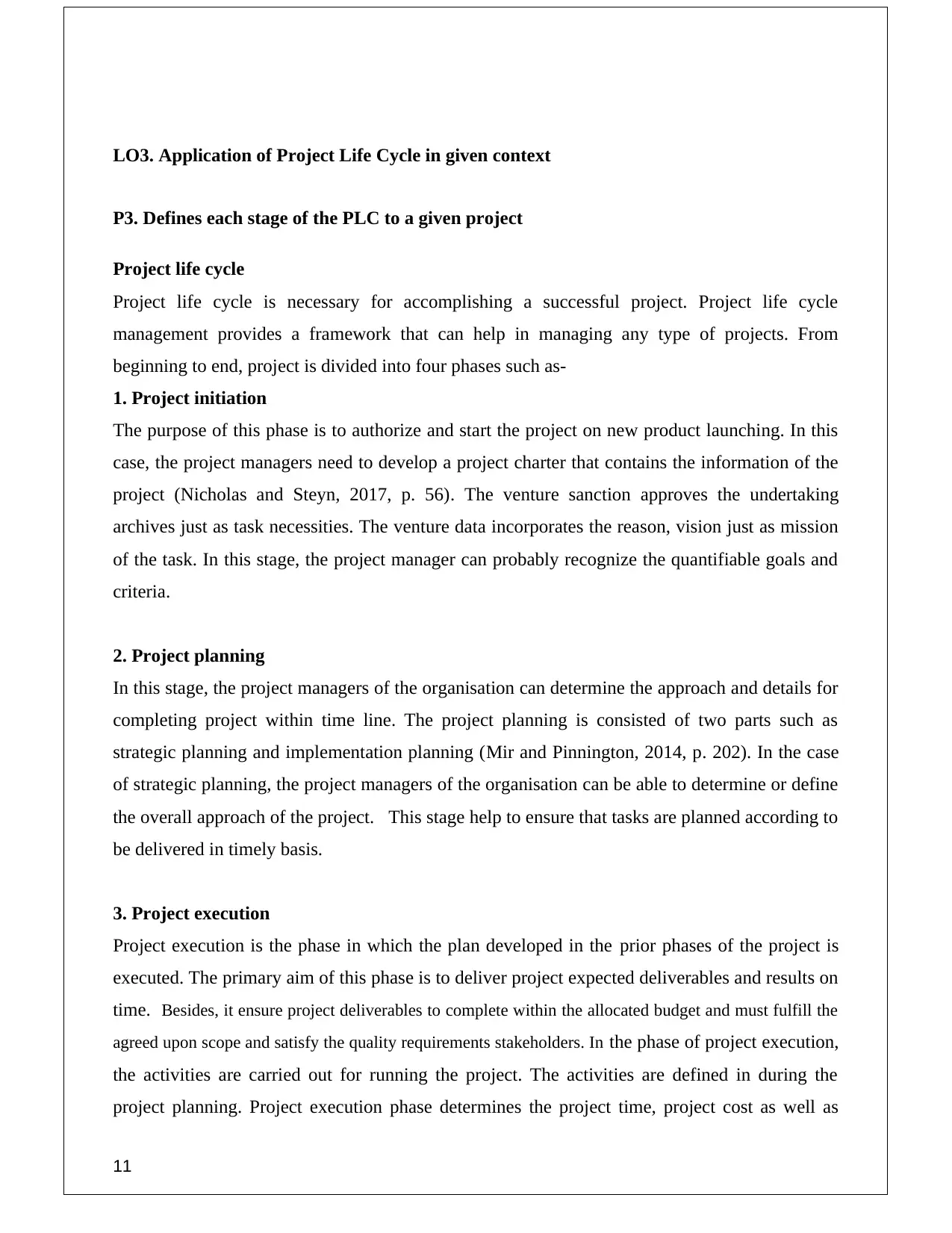
LO3. Application of Project Life Cycle in given context
P3. Defines each stage of the PLC to a given project
Project life cycle
Project life cycle is necessary for accomplishing a successful project. Project life cycle
management provides a framework that can help in managing any type of projects. From
beginning to end, project is divided into four phases such as-
1. Project initiation
The purpose of this phase is to authorize and start the project on new product launching. In this
case, the project managers need to develop a project charter that contains the information of the
project (Nicholas and Steyn, 2017, p. 56). The venture sanction approves the undertaking
archives just as task necessities. The venture data incorporates the reason, vision just as mission
of the task. In this stage, the project manager can probably recognize the quantifiable goals and
criteria.
2. Project planning
In this stage, the project managers of the organisation can determine the approach and details for
completing project within time line. The project planning is consisted of two parts such as
strategic planning and implementation planning (Mir and Pinnington, 2014, p. 202). In the case
of strategic planning, the project managers of the organisation can be able to determine or define
the overall approach of the project. This stage help to ensure that tasks are planned according to
be delivered in timely basis.
3. Project execution
Project execution is the phase in which the plan developed in the prior phases of the project is
executed. The primary aim of this phase is to deliver project expected deliverables and results on
time. Besides, it ensure project deliverables to complete within the allocated budget and must fulfill the
agreed upon scope and satisfy the quality requirements stakeholders. In the phase of project execution,
the activities are carried out for running the project. The activities are defined in during the
project planning. Project execution phase determines the project time, project cost as well as
11
P3. Defines each stage of the PLC to a given project
Project life cycle
Project life cycle is necessary for accomplishing a successful project. Project life cycle
management provides a framework that can help in managing any type of projects. From
beginning to end, project is divided into four phases such as-
1. Project initiation
The purpose of this phase is to authorize and start the project on new product launching. In this
case, the project managers need to develop a project charter that contains the information of the
project (Nicholas and Steyn, 2017, p. 56). The venture sanction approves the undertaking
archives just as task necessities. The venture data incorporates the reason, vision just as mission
of the task. In this stage, the project manager can probably recognize the quantifiable goals and
criteria.
2. Project planning
In this stage, the project managers of the organisation can determine the approach and details for
completing project within time line. The project planning is consisted of two parts such as
strategic planning and implementation planning (Mir and Pinnington, 2014, p. 202). In the case
of strategic planning, the project managers of the organisation can be able to determine or define
the overall approach of the project. This stage help to ensure that tasks are planned according to
be delivered in timely basis.
3. Project execution
Project execution is the phase in which the plan developed in the prior phases of the project is
executed. The primary aim of this phase is to deliver project expected deliverables and results on
time. Besides, it ensure project deliverables to complete within the allocated budget and must fulfill the
agreed upon scope and satisfy the quality requirements stakeholders. In the phase of project execution,
the activities are carried out for running the project. The activities are defined in during the
project planning. Project execution phase determines the project time, project cost as well as
11
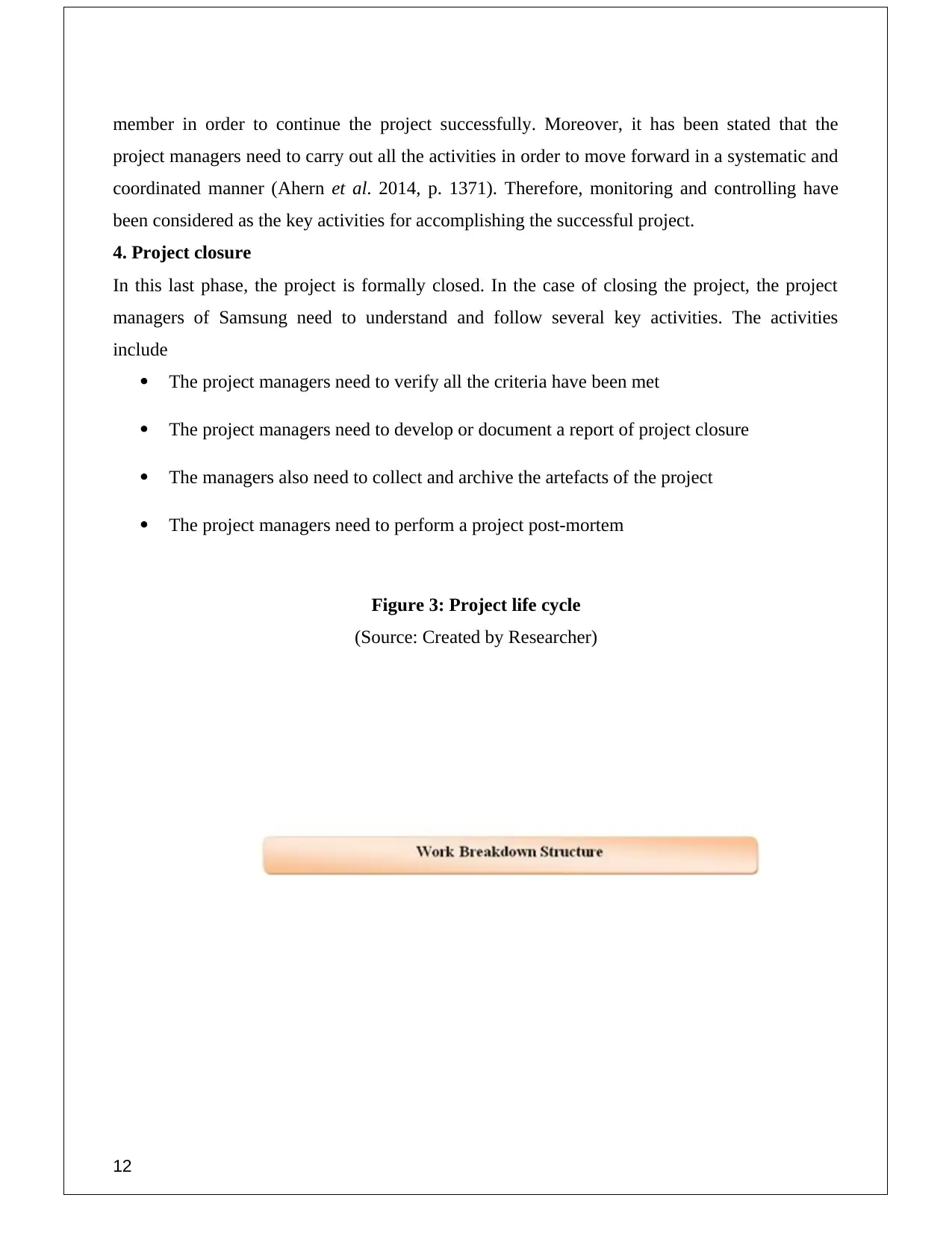
member in order to continue the project successfully. Moreover, it has been stated that the
project managers need to carry out all the activities in order to move forward in a systematic and
coordinated manner (Ahern et al. 2014, p. 1371). Therefore, monitoring and controlling have
been considered as the key activities for accomplishing the successful project.
4. Project closure
In this last phase, the project is formally closed. In the case of closing the project, the project
managers of Samsung need to understand and follow several key activities. The activities
include
The project managers need to verify all the criteria have been met
The project managers need to develop or document a report of project closure
The managers also need to collect and archive the artefacts of the project
The project managers need to perform a project post-mortem
Figure 3: Project life cycle
(Source: Created by Researcher)
12
project managers need to carry out all the activities in order to move forward in a systematic and
coordinated manner (Ahern et al. 2014, p. 1371). Therefore, monitoring and controlling have
been considered as the key activities for accomplishing the successful project.
4. Project closure
In this last phase, the project is formally closed. In the case of closing the project, the project
managers of Samsung need to understand and follow several key activities. The activities
include
The project managers need to verify all the criteria have been met
The project managers need to develop or document a report of project closure
The managers also need to collect and archive the artefacts of the project
The project managers need to perform a project post-mortem
Figure 3: Project life cycle
(Source: Created by Researcher)
12
⊘ This is a preview!⊘
Do you want full access?
Subscribe today to unlock all pages.

Trusted by 1+ million students worldwide
1 out of 20
Related Documents
Your All-in-One AI-Powered Toolkit for Academic Success.
+13062052269
info@desklib.com
Available 24*7 on WhatsApp / Email
![[object Object]](/_next/static/media/star-bottom.7253800d.svg)
Unlock your academic potential
Copyright © 2020–2025 A2Z Services. All Rights Reserved. Developed and managed by ZUCOL.





